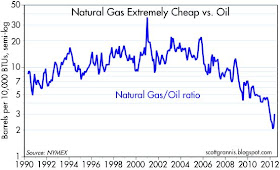As the chart above shows, the U.S. equity market has been outperforming its Eurozone counterpart ever since 2001.
This chart quantifies the outperformance, by showing the ratio of the S&P 500 to the Euro Stoxx index since 2001. U.S. equities have outperformed by an astounding 125% since the Eurozone glory days of early 2001. (Correcting for the fact that the Euro has appreciate vis a vis the dollar by some 37% since then, U.S. equities have still outperformed by an impressive 63%.) Europe's underperformance relative to the U.S. would be the equivalent of many trillions of dollars of foregone income.
It's only been in the last year or two that this outperformance has really gathered speed. The chart above shows the ratio of the two equity indices from the beginning of last year. Here we see that U.S. equities have outperformed by over 40%. (And correcting for the Euro's depreciation against the dollar over this period, US equities have outperformed by over 50%.)
My point here is that the concerns over the eventual size and impact of Eurozone defaults is misplaced. The losses resulting from the profligate borrow-and-spend policies of Greece, Spain, Italy, Portugal, etc., have already occurred in an economic sense. The losses began to accrue from the moment these countries took advantage of the strong euro to borrow money that was used to support lavish lifestyles for public sector employees, corporate cronies, and other beneficiaries of income redistribution. Very little of the money went to productive purposes, so there is nothing to show for it.
It's wise to remember that debt is a zero-sum game in an accounting sense. When Greece declares default, its creditors must take the hit to their bottom line, but the Greek government wins because it has relieved itself of the need to make interest and debt repayments. In the real world, Greece's creditors began losing money many years ago as Greece squandered the money it borrowed. For many years, Europe collectively diverted massive amounts of scare resources to the Southern Eurozone countries, and the money and the resources were consumed rather than invested, so there is nothing to recover.
The real losses are shown in the charts above, and they have manifested themselves in more than a decade of serious economic underperformance. This is the elephant in the room, not the potential impact of PIIGS' defaults on the Eurozone banking system.
Given the degree of Eurozone underperformance, I would be tempted to buy Eurozone equities, but only if and when the PIIGS governments decide to address their true underlying problem. They need to radically cut back the size and scope of their governments, and at the same time eschew any effort to raise taxes to close their funding gaps. Raising taxes only serves to validate the size of government; instead, government must be shrunk to fit the ability of the private sector to afford. This will of course be difficult, since Europe has long been addicted to Big Government, and Big Government will not consent to go into rehab until it has exhausted all other efforts at reform. So I don't see it happening soon, but I'll be watching closely, as will all other serious investors.
And of course, all of this is a timely lesson for the U.S. Our problem is not a shortfall of revenues, it's an excess of unproductive spending.


















































